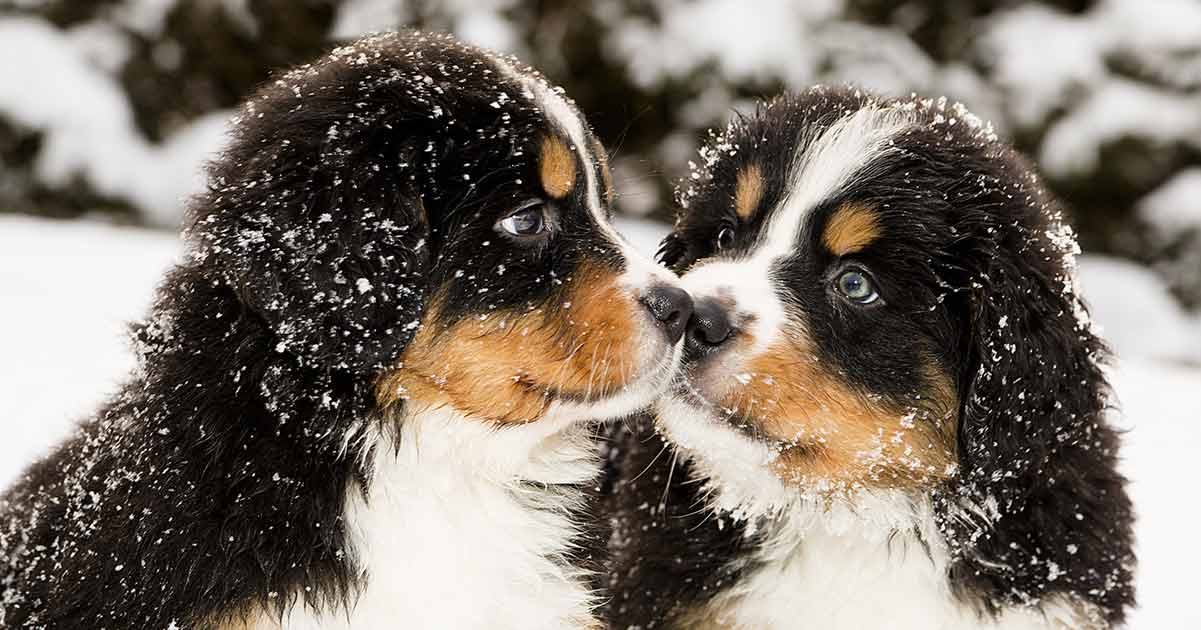
There is something special about really big dogs. Something that makes us feel warm and safe. From the story of Peter Pan to the tragic tale of Gelert, literature and folklore brims with legends of giant dogs that loyally protect their human friends. Big dogs are often tall and leggy, but they can be broad and weigh in at over 100lbs as adults.
Contents
Many of the largest breeds living among us today have a long and proud history of serving mankind. And we are all curious to know which is the tallest, heaviest, and biggest dog in the world. You’ll find plenty of fascinating facts about your favorite large breeds here plus the answers to all your big dog questions!
Big Dog Breeds
There are nineteen different breeds or types of big dogs included on this list of largest dog breeds. And these can be divided into two groups
- The hounds (Irish Wolfhound, Scottish Deerhound)
- The working group (all the remaining breeds)
The working group breeds can be roughly divided into
- Mastiffs
- Mountain Dogs
Largest dog breed type: mastiff
Many in the working group are molosser or mastiff type dogs. Including the Dogue de Bordeaux, Neopolitan Mastiff, Bullmastiff and the Mastiff.
These are dogs that live to protect their families, and some can be very reserved with strangers.
Largest dog breed type: mountain dog
The Mountain type dogs, like the Bernese Mountain Dog, Greater Swiss Mountain Dog, and St Bernard often had a dual guarding and herding role. These are often shaggy coated dogs, extremely resistant to cold, and some are known for their kindly temperaments and good disposition towards children.
#1 Scottish Deerhound 85-110lbs (32 inches)
The Scottish Deerhound – known simply as the ‘Deerhound’ to our UK readers, is the lightest and ‘raciest’ of our largest dog breeds.
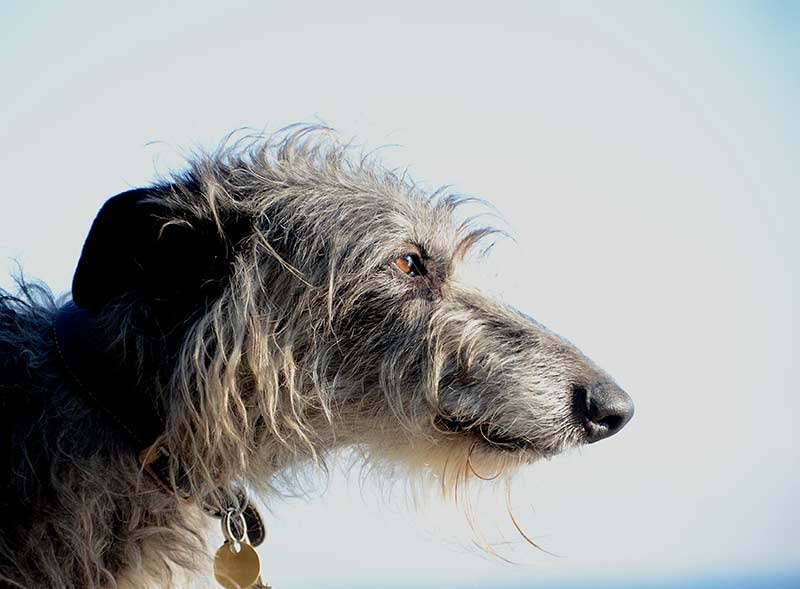
Built for speed, these beautiful dogs were originally bred, as the name suggests, to hunt deer.
The lightest dog in our selection, this is a hound that really needs to stretch his legs and run each day. The rest of the time, he’ll enjoy stretching out on your couch.
A Deerhound could make an enchanting and eyecatching pet, but there’s a catch. Deerhounds have a significant 15% risk of osteosarcoma (bone cancer) and 10% risk of heart problems. A 2004 health survey gave Deerhounds a lifespan of just over 8 and a half years.
Liver shunt is another problem in the breed and puppies should be screened for this.
The Deerhound looks a bit like a huge hairy greyhound and has the same quiet and thoughtful demeanor as his smaller cousins.
He’s unlikely to guard their home, but will be a loving companion for his family.
Check out our fascinating comparison between the Scottish Deerhound and his cousin the Irish Wolfhound
#2 Bernese Mountain Dog 86-110lbs (28 inches)
This is a friendly, hairy, loving and lovable dog whose origins lie in Switzerland. The Bernese Mountain Dog was developed as a farm dog, nimble and clever enough to herd livestock and yet strong enough to pull a cart.
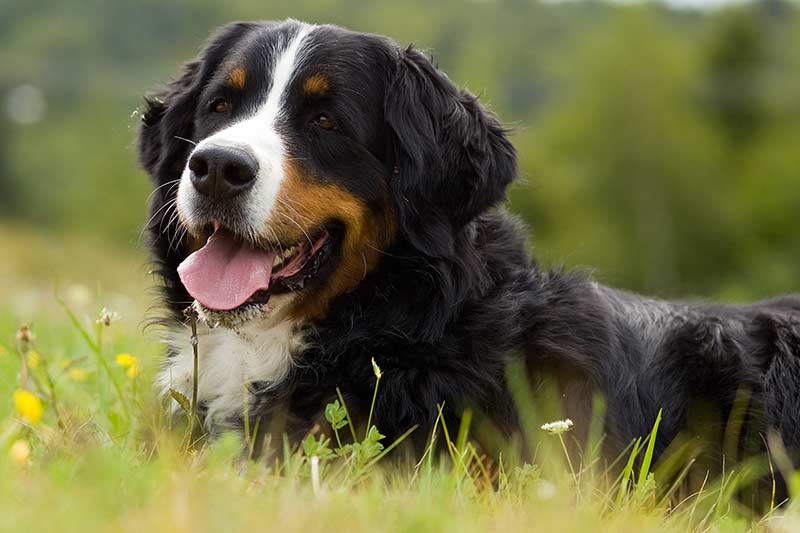
In theory this is an ideal family dog. Great with kids, the Bernese is one of the more popular big breeds. With a kindly temperament and a more moderate size than some of our other giants.
However, all is not ideal in the health department.
Bernese Mountain Dogs have a very high rate of cancer. In one study of nearly 400 dogs, over 45% succumbed to the disease. In a 2005 study carried out by the Bernese Mountain Dog Club Of America the average age at death of over 200 dogs, was 10. The median age of death in a UK study was only 8 years.
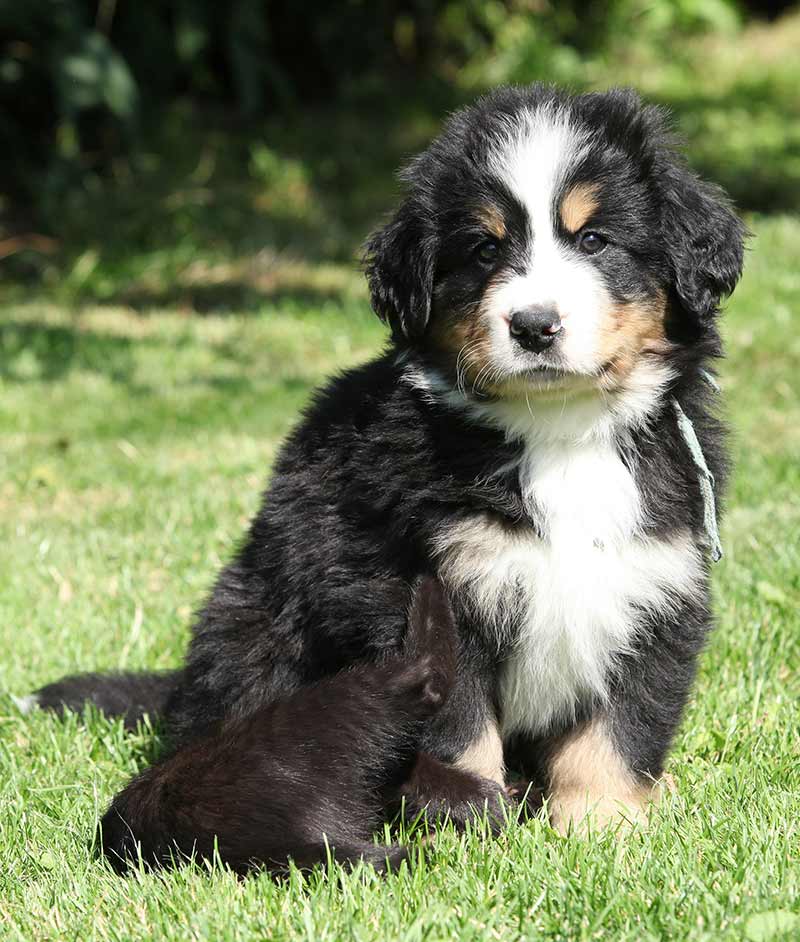
The Bernese has a moderately long and heavy coat and sheds. And is unlikely to be comfortable in very hot climates. Regular grooming is essential and will help to minimize the hair on your couch and carpets.
If you have your heart set on a Bernese, try to find a breeder whose dogs have longer than average lifespans and a lower than average incidence of cancer. Read more in our full guide to the Bernese Mountain Dog
#3 Black Russian Terrier 80-130lbs (30 inches)
The Black Russian Terrier is known as the Russian Black Terrier in the UK. The Kennel Club describe this breed as “large and imposing” with “natural guarding instincts”.
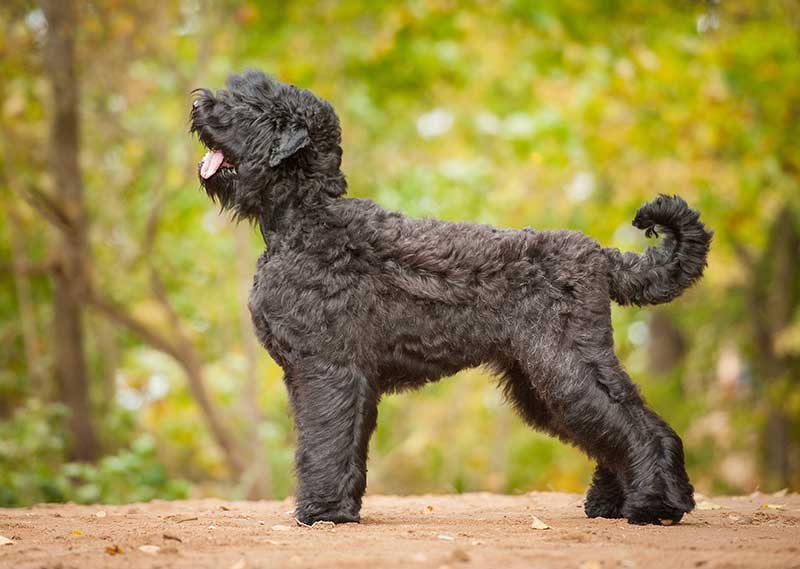
A relatively new breed, the Russian Black Terrier was developed in the 1930s and 1940s in Russia, from a mix of 17 different dog breeds.
The breed was created as a working/guarding dog suitable for military work. And was only finally accepted as a breed in it’s own right by the AKC in 2001
The biggest problem for this breed is it’s lack of genetic diversity and low numbers. The Institute of Canine Biology have placed the Russian Black Terrier on it’s ‘critical list’. This is because the population numbers have fallen so low in the UK.
Black Russian Terriers are few and far between in the USA too.
And you may have to spend a long time on a waiting list for a puppy
#4 Komondor 100lbs +
An adult Komondor in full coat is quite a sight to behold. While the Komondor may look from a distance like a woolly sheep, this is a seriously large working dog with very strong guarding instincts.
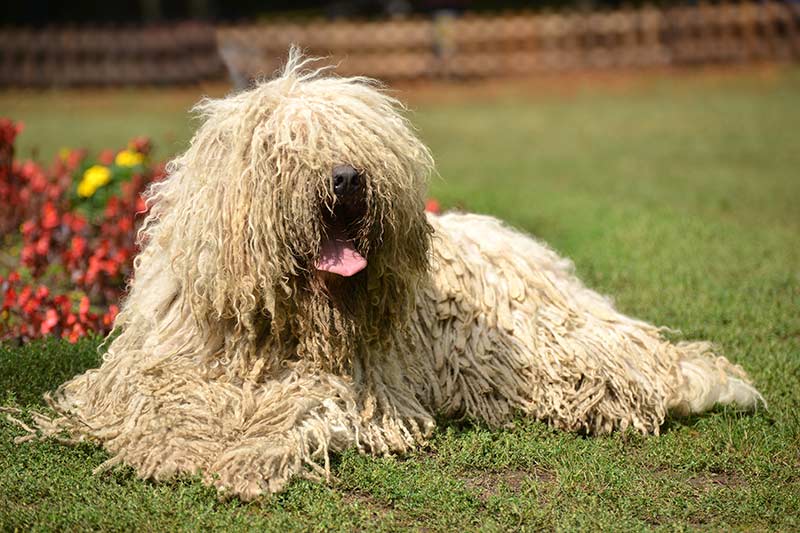
The breeds was developed in Hungary for guarding livestock and when adult has an unusual corded coat. Each cord can be up to 12 inches long so that the resulting coat weighs more than that of any other dog breed.
As with all guarding breeds it is vital that you put a lot of effort into socializing a Komondor puppy, so that he will be safe around visitors and in public when he grows up. This is not a suitable breed for families with small children.
Some Komondors can be noisy too. These are also big dogs that eat a lot and like many big breeds are susceptible to hip dysplasia, and to bloat.
#5 Rottweiler 110-130lbs (27 inches)
Rottweilers have long been popular as protection dogs. And are increasingly popular as family pets.
They are an ancient breed whose origins lie in Germany. The Rottweiler probably began their career as cattle dogs, but when cattle driving became illegal, this multi-talented breed became known as a ‘butcher’s dog’.
Nowadays, when they are not snoozing in front of the family hearth, Rottweilers often turn their hand to protection and guarding work
This is a deeply loyal and courageous breed. They do however need proper training and are best owned by an experienced handler.
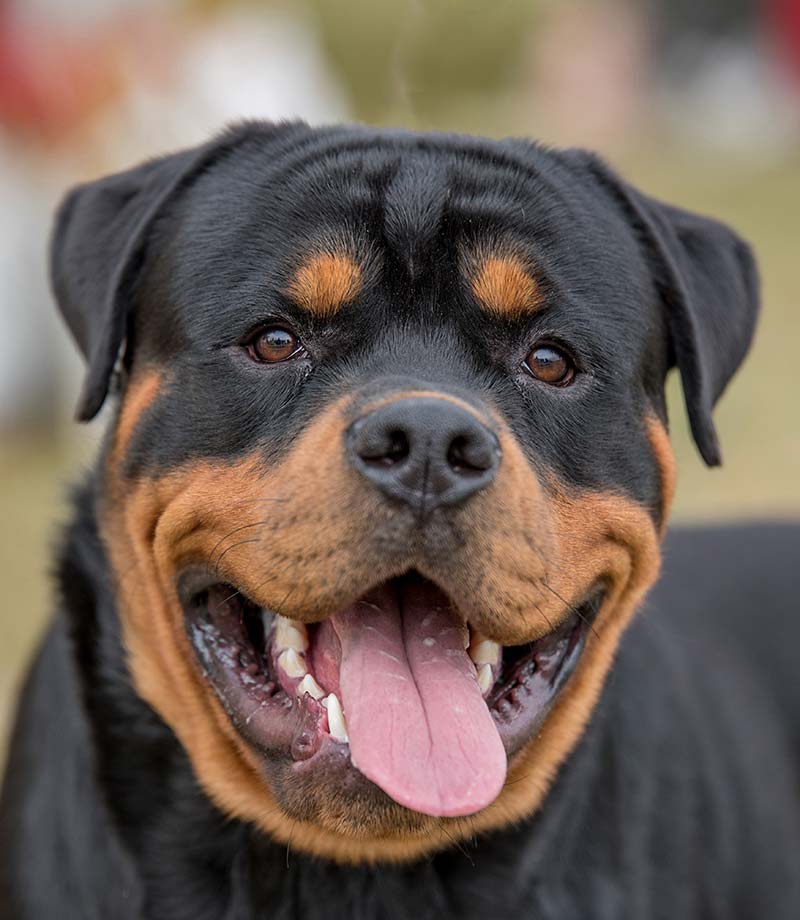
A study published in 2000 showed that, along with Pitbulls, Rottweilers accounted for half of human deaths attributable to dog attacks during a 20 year period.
This does not mean that all Rottweilers are aggressive, or dangerous. And the number are partly because both breeds are very popular.
But it shows that there is a potential for harm that needs proper consideration. And it would be wrong to ignore that fact.
The lifespan of the Rottweiler isn’t long.
In a recent study (see O’Neill below) the median age at death of over a hundred Rotties was just 8 years. Cancer was a big problem for this breed too, with rates of over 45%.
Here’s our full guide to the breed. You can also check out the many popular Rottweiler mixes.
#6 Great Pyrenees 100lb + (32 inches)
The Great Pyrenees is known as the Pyrenean Mountain Dog in the UK where it is classified in the pastoral (herding) group.
It is a tall and predominantly white dog whose origins, like many of our biggest dog breeds, lie in herding and guarding livestock.
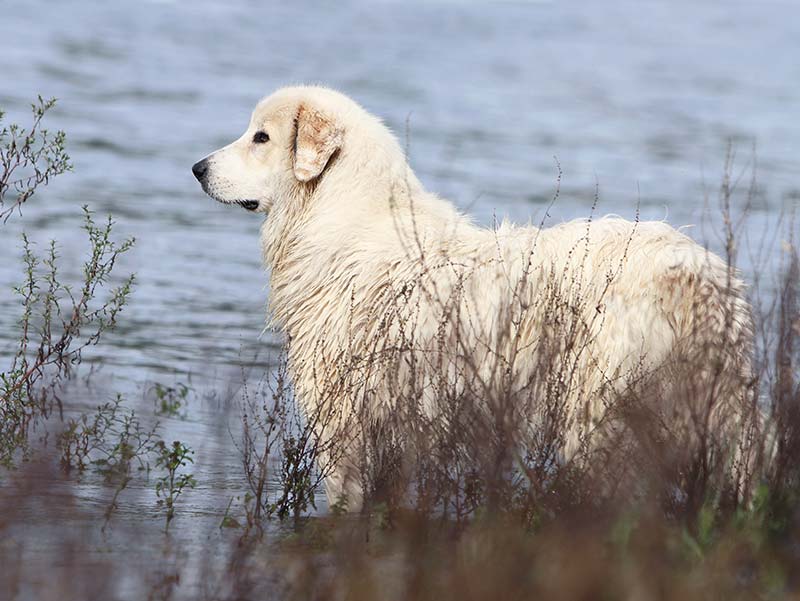
You’ll need plenty of space to accommodate on of these handsome dogs in your home. And a well fenced property if you don’t want this independent dog to wander off.
The magnificent and profuse white coat may have served the original purpose of defending the dog from wolf attacks as well as protecting it from the cold Pyrenean climate. This is a shedding breed and needs some grooming.
Health problems include hip dysplasia and a relatively new neural degeneration disease.
There are tests for these conditions so make sure you ask to see certificates before purchasing a puppy. Check our our breed center for more information.
#7 Dogue De Bordeaux 110lb + (27 inches)
The Dogue De Bordeaux is a muscular mastiff with a rich red coat, that originated in France several hundred years ago.
You can find out all about the history and characteristics of this interesting breed in our detailed guide.
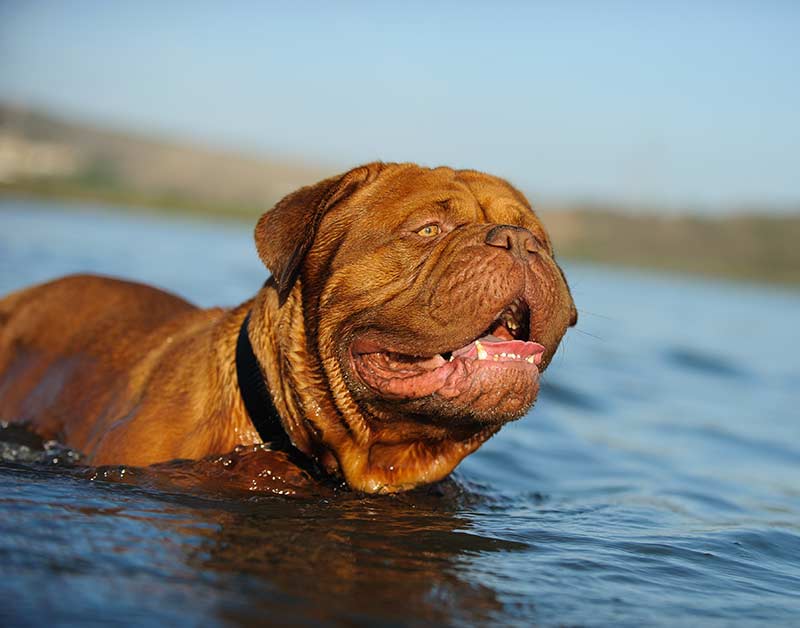
This is a guarding breed and needs intensive and thorough socialization, but perhaps the biggest problem with the Dogue is its greatly reduced lifespan. Check out that guide before you buy!
Sadly, some breeders have also introduced a marked degree of brachycephaly into the breed, with its associated consequences (breathing difficulties and overheating).
The dog in the photo above can be identified as brachycephalic by its short muzzle with accompanying skinfolds, and by the severely pinched entrance to its nostrils.
#8 Irish Wolfhounds 120lbs (34 inches)
The Irish Wolfhound looks for all the world as though he just stepped off a medieval film set.
This is my personal favorite of all the giant breeds and surely one of the most striking of all our breeds in appearance.
The Wolfhound is our tallest hound standing as he does at a minimum of 32 inches at the shoulder. His great size however, is not an advantage when it comes to health. And the breed has a strong propensity for heart troubles.
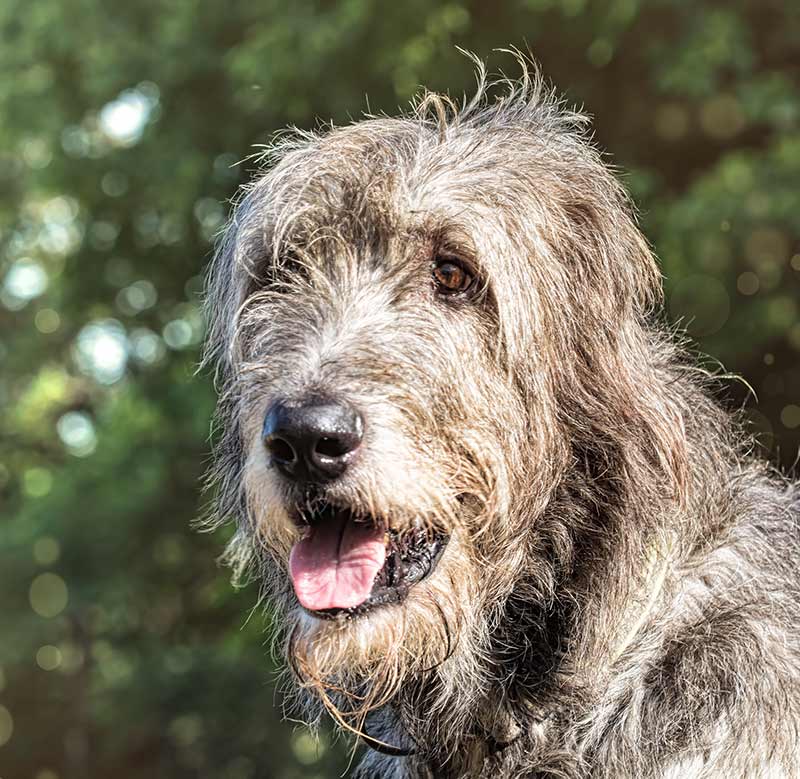
A study published in 2000 looked at over 500 wolfhounds and found heart problems in over 40% of them.
You’ll need plenty of space if you bring one of these beauties into your life. And a passion for long walks!
#9 Bullmastiff 110-130lbs (27 inches)
Bullmastiffs were developed in the 1800s by mixing Mastiff bloodlines with Bulldog bloodlines. This idea was to develop a more protective and aggressive Mastiff type breed.
These dogs were predominantly used by gamekeepers and those living on rural estates, for guarding property and personal protection
According to a health survey carried out in 2004 in the UK, Bullmastiff have a median lifespan of 7 and a half years. Lymphoma – a form of cancer – was responsible for 37 % of the 96 deaths in the report.
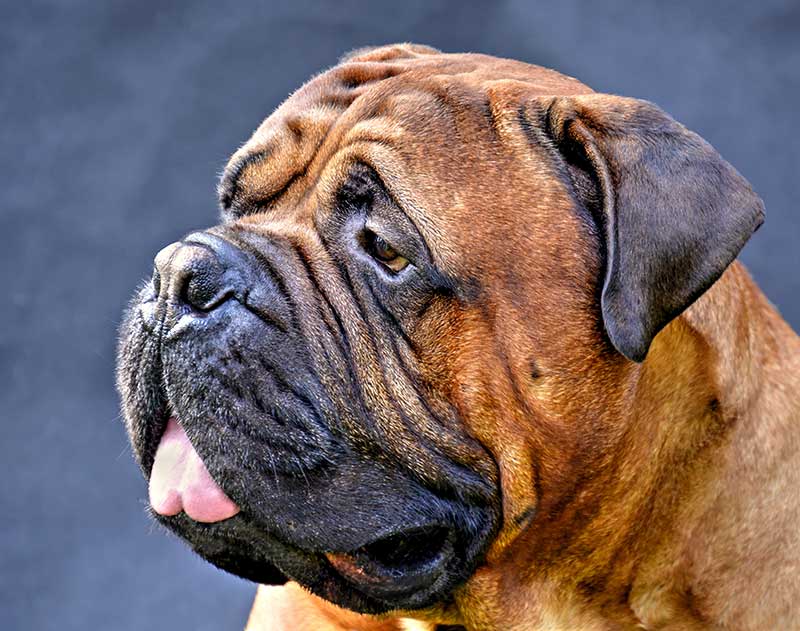
Like the Dogue De Bordeaux, some Bullmastiff lines are being bred to be increasingly brachycephalic. The pinched nostrils of the purebred Bullmastiff in the photo above indicate there are problems with this dog’s respiratory system
This is a powerful, protective dog that needs very thorough socialization, and training. From a safety point of view, it is a breed best suited to an experienced and knowledgeable owner.
#10 Greater Swiss Mountain Dog 115-140lbs (28.5 inches)
Unlike many of our other large mountain breeds, the Greater Swiss Mountain dog has a short, easy care coat.
This was another, multi-purpose, hard working farm dog, capable both of pulling heavy loads and of helping to drive cattle to market.
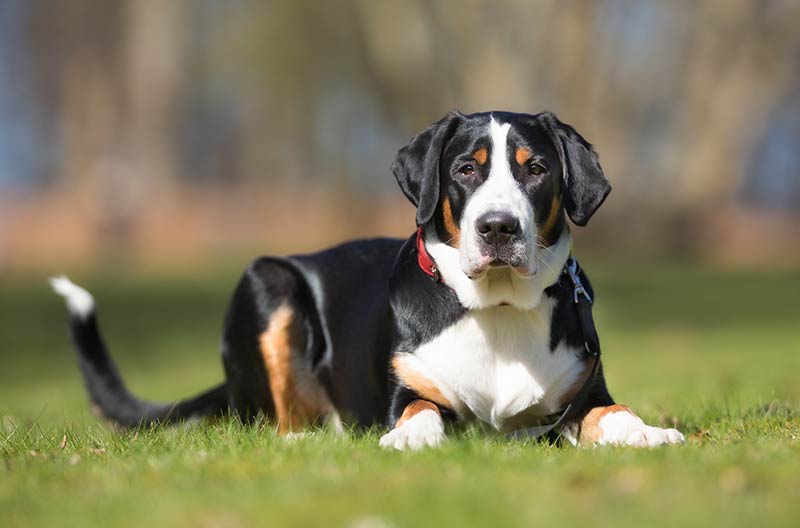
Modern Greater Swiss Mountain dogs are generally friendly dogs, though aggression has occasionally been reported in the breed.
As always looking for a responsible breeder, that puts temperament before all else, is doubly important when you are buying a large and powerful dog
Often considered to be one of the healthier big breeds, a 2001 health survey revealed that the most common problems in the breed included bloat, and epilepsy.
This is a well constructed dog that should be able to lead an active life.
#11 Newfoundland 130-150lbs (28 inches)
This is a breed widely known for its large size, shaggy coat, and wonderful temperament.
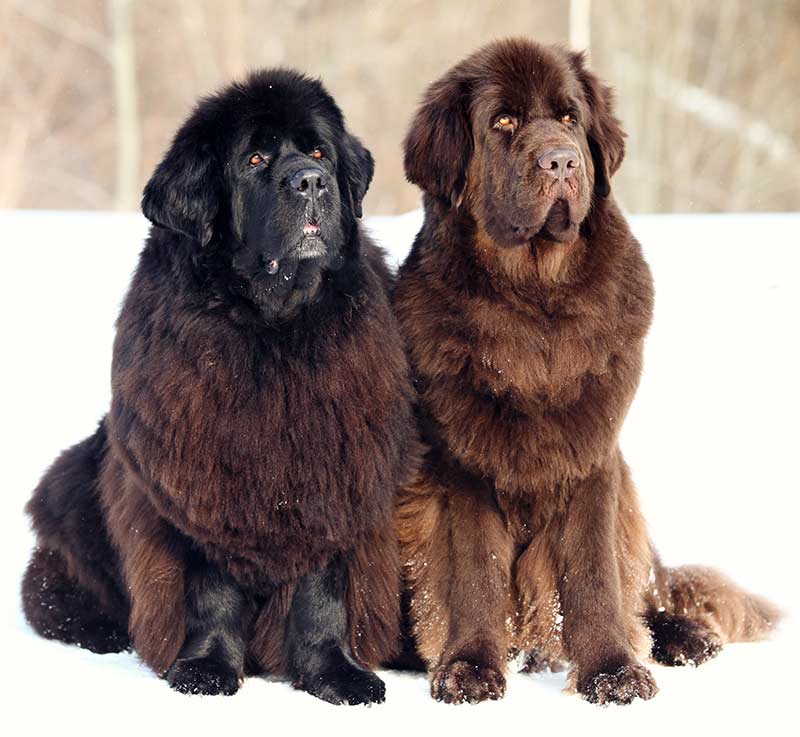
Bred to work in the freezing waters of Northern Canada the Newfoundland is a powerful swimmer and a favorite breed for live savers and water rescue.
On the downside, Newfies can be heavy ‘droolers’ and in common with several other large breed dogs Newfoundlands are prone to heart problems, and hip dysplasia. They are also susceptible to a bladder/kidney problem that every puppy’s parents should have been tested for before breeding.
In the 2004 UK health survey the median age at death for Newfoundlands was 9 years and 8 months.
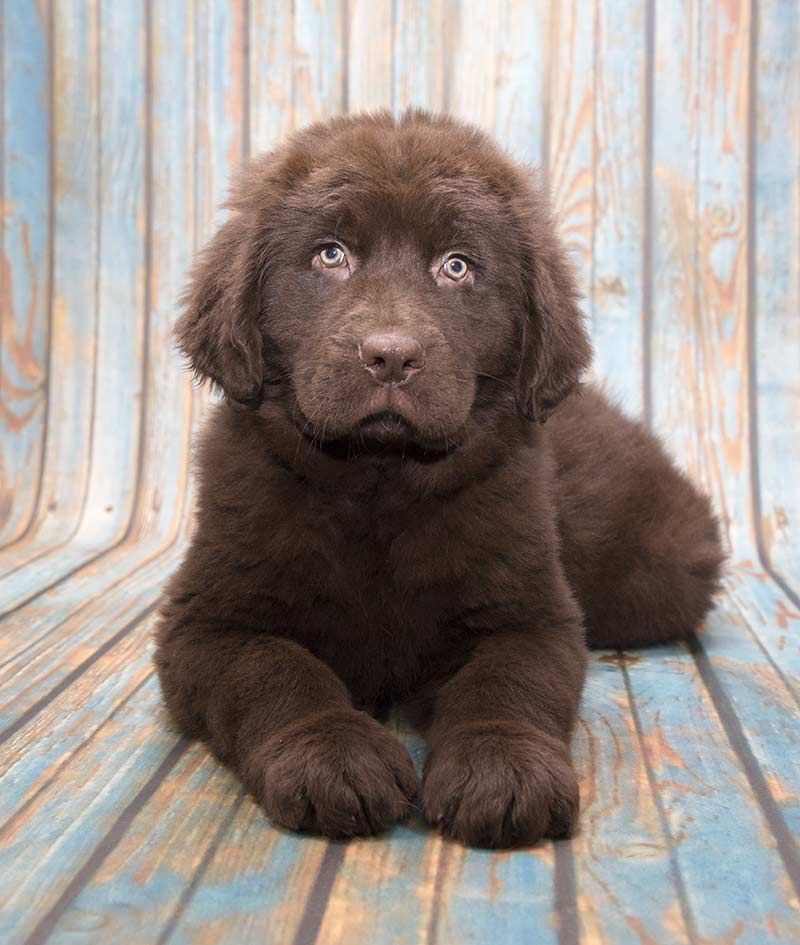
The Newfie comes in three colors, brown, black or black and white and is a gentle giant that makes a lovely family dog for those with sufficient space in their lives.
#12 Anatolian Shepherd Dog 110-150lbs (29 inches)
The Anatolian Shepherd Dog is a breed developed to work alongside nomadic herding peoples in Turkey. The principle role of the Anatolian Shepherd is to guard livestock.
This is a very hardy, short, or rough, coated working dog with a natural guarding instinct and suspicion of strangers.
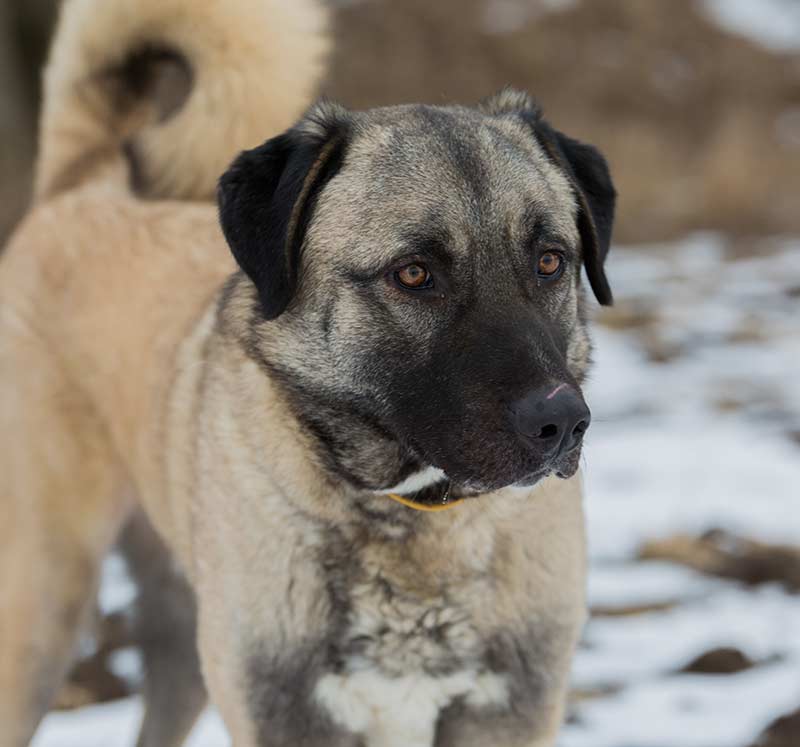
The Anatolian Shepherd is a very protective breed and for safety reasons, the Anatolian Shepherd Dog Club of North America recommend that these dogs should “should never be allowed off leash off their property”
The Anatolian breed may be longer lived than most of our giant breeds. There were only 23 deaths recorded for this breed in the 2004 UK survey, but they showed a median age at death of over 11 years.
However, this beautiful dog is a specialist breed and not generally suitable as a family pet
#13 Neapolitan Mastiff 150lbs (31 inches)
As its name suggests, the origins of the Neapolitan Mastiff lie in Southern Italy. Sometimes referred to as Mastinos, or Neos, the breed is an ancient one whose ancestors go back to Roman times.
Sadly, in addition to high risk of joint problems, modern Neapolitan Mastiffs have suffered from exaggerations in conformation.
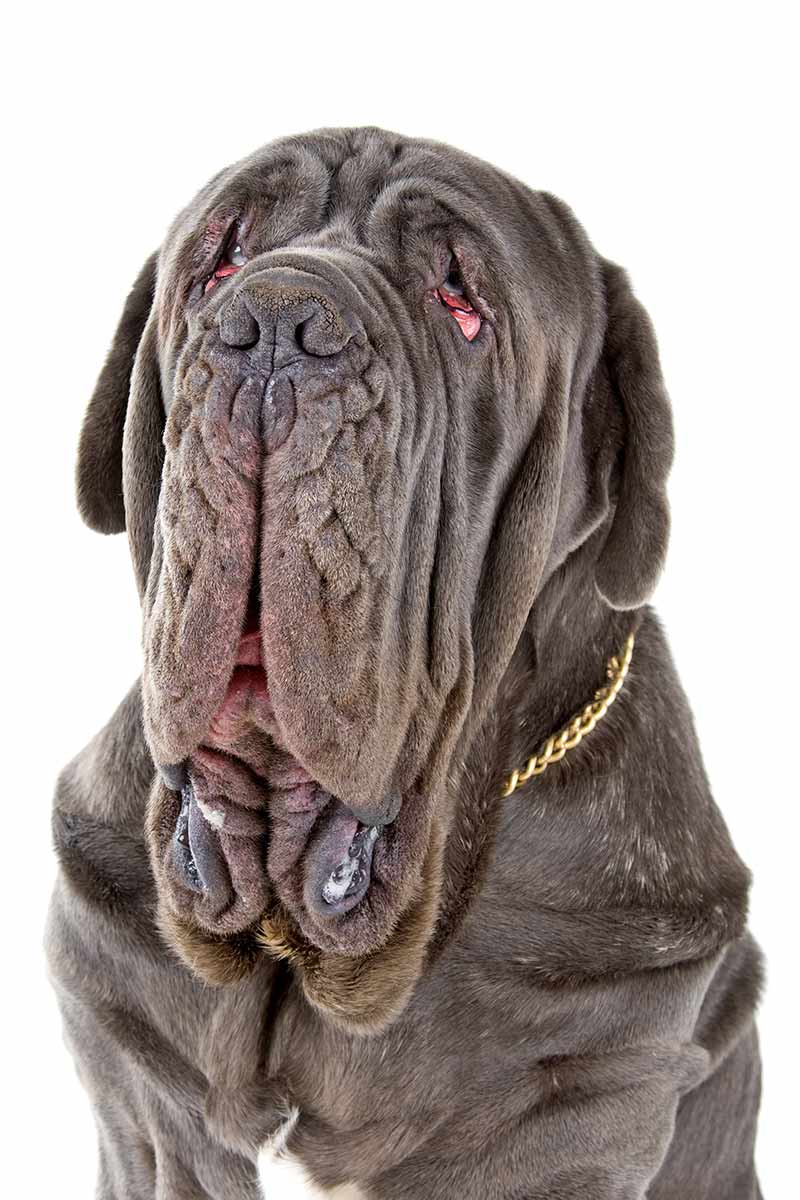
In particular from an excess of loose skin and its associated eye problems. Cancer and heart issues are also a problem in the breed
These are not an ideal first dog, nor are they usually a great dog to have around small children.
This is a guarding breed and these are dogs that can be very wary of visitors.
#14 Tibetan Mastiff 100-160lbs (30 inches)
This is another working dog originally bred to protect homes and guard livestock. The Tibetan Mastiff has hit the headlines on several occasions for being both an ‘ancient’ breed, and an ‘expensive’ one.
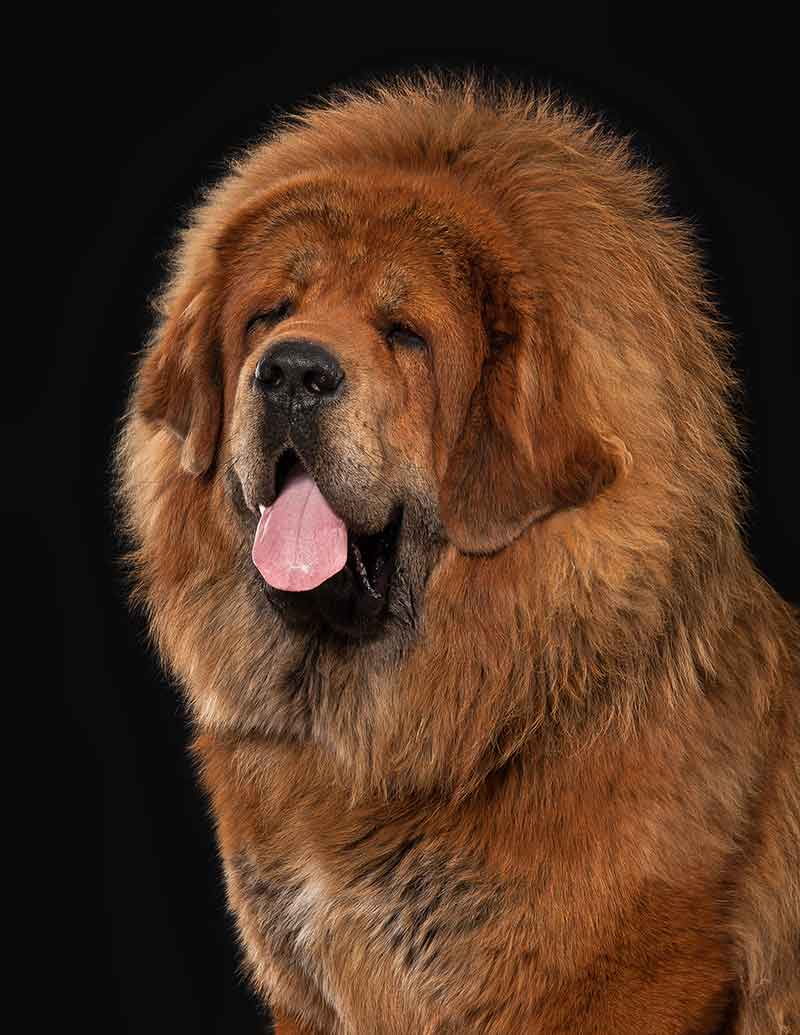
Despite its name, in appearance, this is a breed that is more ‘mountain dog’ than ‘mastiff’.
When it comes to temperament, the Tibetan Mastiff is a very independent breed that can be highly suspicious of strangers. And its health may have been compromised by small numbers and consequent small gene pool
#15 Leonberger 110-170lbs (31.5 inches)
The Leonberger is one of the few really big breeds that rarely drools.
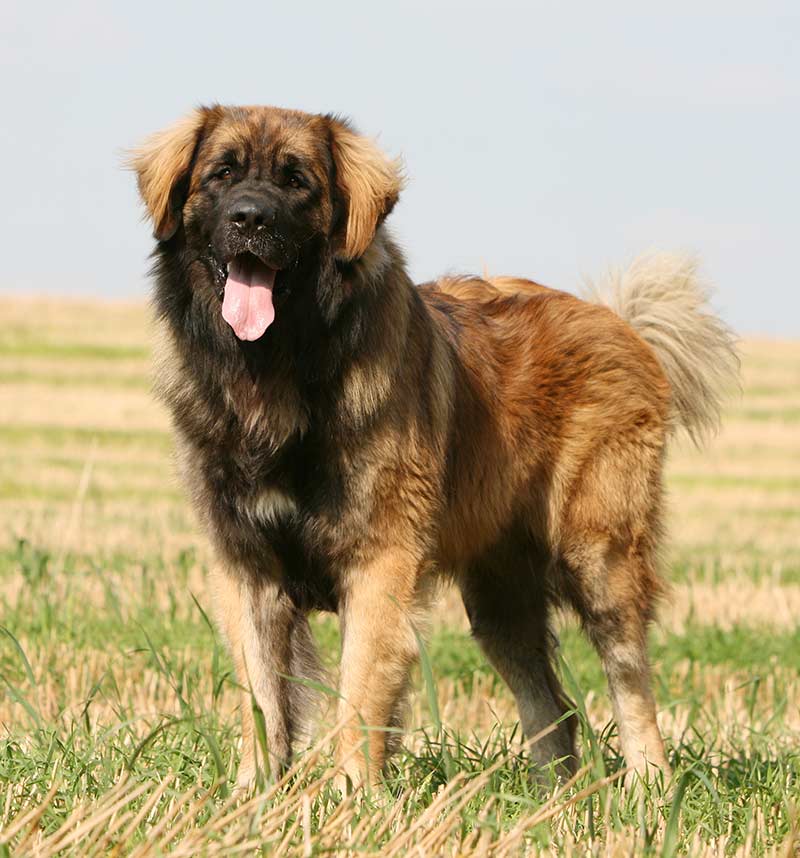
Rumor has it that the mayor of Leonberg helped to create the breed because he wanted a dog with a lion-like appearance to compliment the name and crest of the town.
As with most big breeds there are longevity issues with this beautiful dog. The 2004 study in the UK reported on 47 Leonberger deaths and found the median age at death to be 7 years and one month. Cancer was the leading cause of death accounting for the demise of just under half of those dogs.
Breeders have however, been successful at reducing rates of hip dysplasia in the breed.
The Leonberger is quite agile for a big dog and sometimes works in search and rescue, as well as being a companion breed. Like most Mountain Dogs, the Leonberger has a substantial and very warm coat, and will shed.
Male and female Leonbergers are visibly different with males have a significantly more masculine conformation
#16 St Bernard 140-180lbs (30 inches)
Made famous by the movie ‘Beethoven’ The St Bernard is a familiar breed to most of us, and is the 49th most popular breed in the USA.
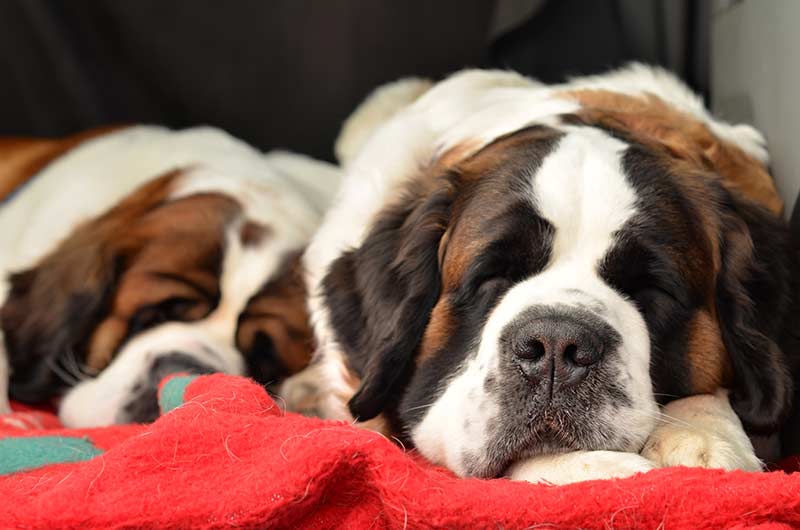
St Bernard history goes back a very long way, and while some of the tales you hear are speculation there are records that tell us quite a lot.
Their job was to rescue snowbound travelers, and there is no doubt that many lives were saved by these giant dogs.
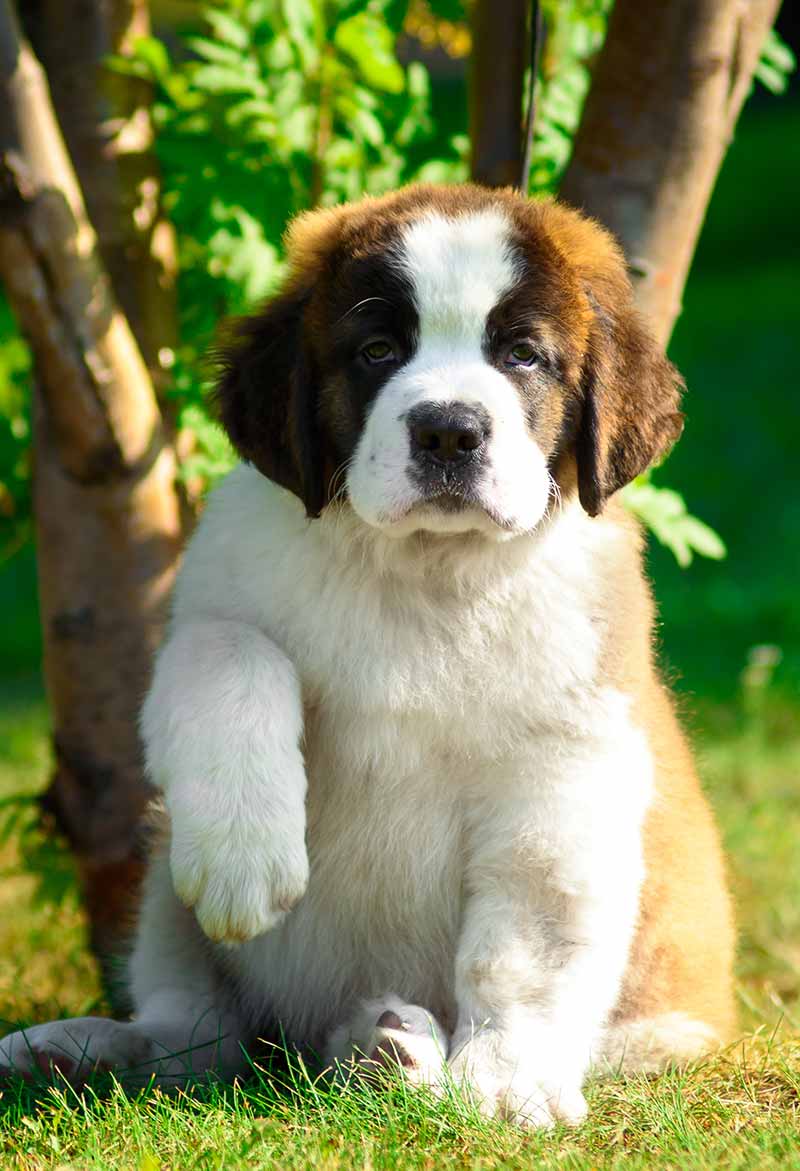
With a lifespan of just 7 years or so, this is another big breed that suffers with heart problems, cancer and hip dysplasia. And like other big breeds is susceptible to heatstroke and bloat.
The St Bernard does however have an exemplary temperament and if you have space enough for one of these giants, they will make you a gentle and kind companion.
#17 Great Dane 120-200lbs (34 inches)
Another familiar breed, Great Danes often hit the headlines. Usually because one has broken a record of some kind or sometimes for eating, or costing a lot.
This is a very tall dog, and no lightweight!
The Great Dane is a German breed and may have acquired its name to avoid association with political tensions involving Germany
The popular giant is one of the most numerous of our giant breeds and the 14th most popular dog in the USA.
Another very short lived dog it has a median age at death of just 6 and a half years
Being a contender for the biggest dog in the world isn’t all fun. Great Danes suffer from gastrointestinal problems including bloat, heart troubles and bone cancer.
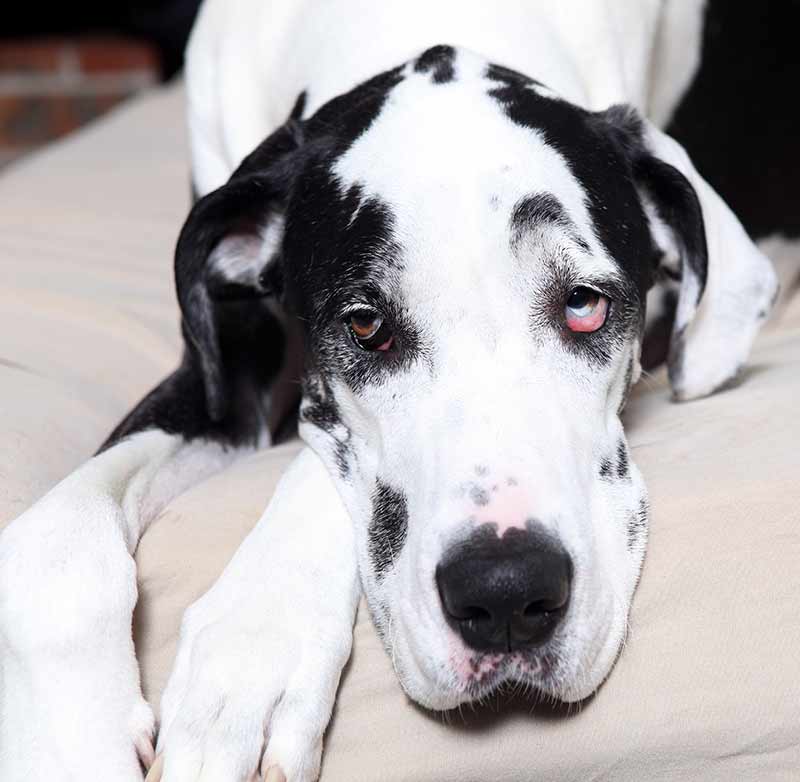
In the USA Danes are often ear cropped, a painful procedure carried out under anesthetic on three or four month old puppies. You don’t need to crop your puppy’s ears if you don’t want to, ear cropping has no value other than for cosmetic purposes.
Some Great Danes are also now being subjected to exaggerations of facial conformation. Including huge droopy lips and excess facial skin that drags down the lower eyelids exposing the dog to painful eye problems
If you are thinking of buying a Great Dane, especially a harlequin, do some research first to make sure you use a knowledgeable breeder who follows best practice for avoiding some of these issues. Read more in our Great Dane breed guide.
#18 Boerboel 150-200lb (27 inches)
The Boerboel is another short coated mastiff breed. This time from South Africa. It’s an uncommon dog – number 131 on the popularity list. And was only registered with the AKC in 2014
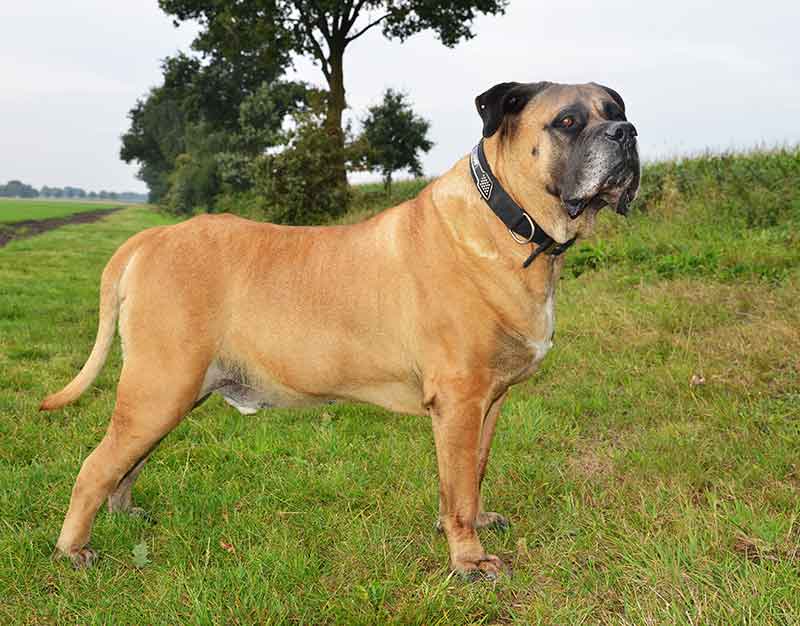
Originally bred as a farm dog and guard, the Boerboel is a powerful breed, with strong protective instincts.
Bred to have sufficient aggression and courage to take on large African predators, the Boerboel needs very thorough training and socialization, and experienced handling.
The American Boerboel Club encourage owners to participate in a sport or activity such as Schutzhund to channel the dog’s energy and confidence in a useful way.
#19 Mastiff 160-230lbs (30 inches +)
Fortunately, despite its ancient origins as a fighting and guarding breed dating back to Roman times, the Mastiff is as docile as it is large.
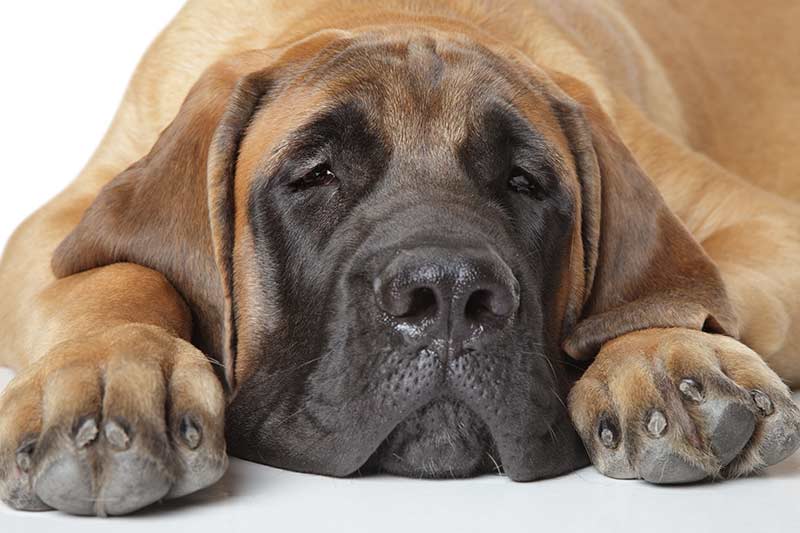
Unfortunately the breed has suffered from a small gene pool (only 14 individuals were left at the end of WWII) and from poor breeding practices on the part of some breeders.
These have resulted in exaggerated features including excessive skin and wrinkling, and weakness of the hindquarters. As a result, the Kennel Club has listed the Mastiff as a Category 3 in its breedwatch scheme
Another shortlived breed, the median age at death is just 7 years. The breed suffers from a range of health problems including eye problems, cancer, epilepsy and the joint issues that affect all these large dogs. The Mastiff Club produce a useful information sheet on these issues
The Mastiff truly is a gentle giant, and wins the hearts of all who get to know him. But there is a way to go before this lovely breed can be considered healthy.
The Caucasian Shepherd Dog
Also known as the Russian Bear Dog, the Caucasian Shepherd is another massive guarding breed.
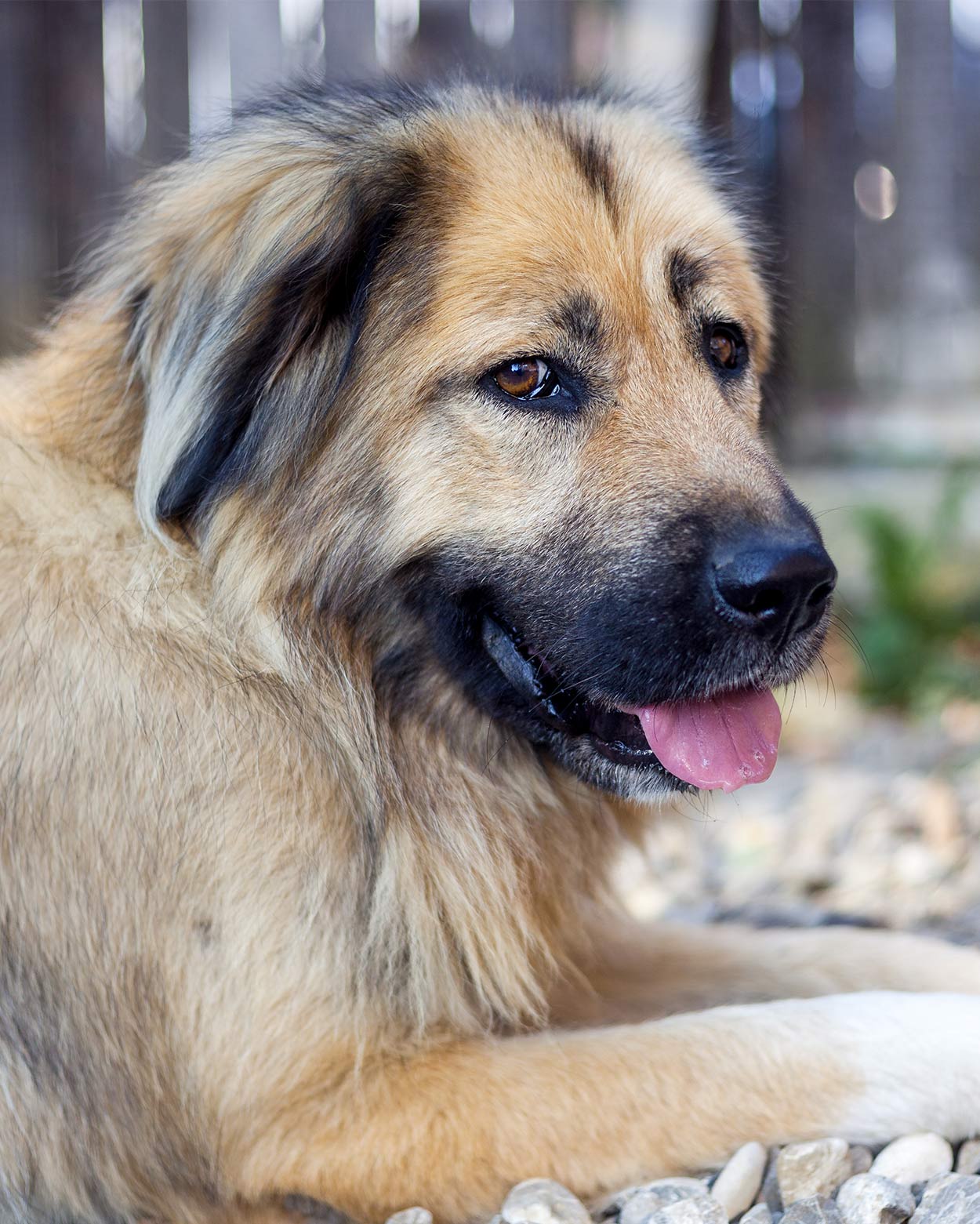
This tall and thick coated dog was bred to fight wolves and protect flocks of sheep in the mountainous Caucasus region.
The Biggest Dogs Ever
The tallest dog in the world today is a Great Dane from England called Freddy.
Freddy is 3 foot 4 and 3/4 inches tall and his owner reportedly spends over $13,000 a year on dog food
Freddy is the biggest dog in the world by height. The heaviest dogs in the world tend to be Mastiffs, but celebrating massive weights can be inappropriate as it may encourage obesity. So we’ll stick to how tall dogs are when talking about the biggest dog in the world ‘title’.
The biggest dog in the world ever by height, was a Great Dane named Zeus from Michigan. Like most Great Danes he died far too young at the age of 5 in 2014. He measured 3 feet and 8 inches tall!
Great Danes are heavy, though some other breeds are heavier. Remember, height is generally considered the best way to allocate the biggest dog in the world title, as weight can be more easily manipulated by overfeeding.
Are All Big Dogs Furry?
The mastiffs tend to have short flat coats. The two hounds have broken coats. And all the remaining ten big breeds have thicker coats with four breeds being especially fluffy
They four big furry dogs with the fluffiest coats are Newfoundlands, Tibetan Mastiffs, Great Pyrenees and Leonbergers.
The Rottweiler, Dogue De Bordeaux, Mastiff, Bull Mastiff and Greater Swiss Mountain Dog, Boerboel, Neopolitan Mastiff and Great Dane have short flat coats.
The two hounds – Irish Wolfhound and Scottish Deerhound have broken coats that are not particularly long. The St Bernard has a moderately short coat but it’s much thicker than that of a mastiff.
Best Big Dogs For Familes
Some of these big breeds are very loving and considerate towards all small children. Others are more protective and may be problematic around children they don’t know.
If you have little ones, either your own, or visitors to your home, then a gentle Newfoundland for example will be a better choice than the more active and protective Russian Terrier.
Our best large dog breeds for families are Bernese Mountain Dogs, Newfoundlands and St Bernards.
Your choice may also depend partly on where you live. Quite a few of our giant breeds, were bred to work outdoors in cold climates.
Large dogs with very thick coats can struggle a bit in warm climates. It’s easier to keep cool if you are small and heatstroke is a real risk in very large dogs.
So if you live in Florida, a Newfoundland might not be the best choice for a family pet
Big Guarding Breeds
Some people are looking for a dog to protect them. But guarding breeds don’t always make great pets for families with small children. And they can be a huge responsibility
Remember that just because your guarding breed dog loves your children, it does not mean that your dog will love their friends, or your friends for that matter.
Using a dog for personal protection is always potentially hazardous especially where kids are involved and requires serious planning, and thought.
You also need to be aware that it isn’t really safe to bed share with a dog weighing ten stones.
Are Big Dogs Healthy?
Being a giant dog isn’t always a bed of roses. In fact it comes with some disadvantages. We’ve looked at some of the health problems affecting each breed. But it would be wrong to talk about big dogs without emphasizing their health issues in general.
Shorter Lifespans
Gigantism in dogs is associated with reduced longevity. The median lifespan for a Great Dane is just six years. The Dogue De Bordeaux is even shorter. This is directly linked to their size.
Compare those six short years with the fourteen years you can expect to share with a miniature Poodle. Six years might seem a long way away with a new puppy in your arms, but it comes around far to quickly for most of us.
Joint Problems
Apart from exaggerated size, most of our big breeds are reasonably well constructed. But not all. Dogs function best when their legs are in proportion to their spine, and when there is a defined muzzle at the front of the skull. And most of the largest breed dogs do fit this description.
However, there are problems, with stresses and strains that a bigger body puts upon joints. And hip dysplasia is a problem in many big breeds. As is bloat – a condition that tends to affect larger more deep chested dogs.
Some of our biggest dog breeds have suffered at the hands of their breeders.
Exaggerated Features
The Neopolitan Mastiff for example has become increasingly exaggerated in the last few decades. The excess saggy skin around the face means that the delicate membranes under the eyes are often exposed to the elements and become inflamed or infected.
A very painful condition for the dog. And this situation is also creeping into some lines of Great Danes and affects English Mastiffs too
The Bullmastiff, and the Dogue De Bordeaux have become increasingly brachycephalic or short in the skull. This affects a dog’s ability to breath and cool itself efficiently.
These changes don’t happen by accident, they are man made and the general public are now becoming more aware of our responsibility to breed dogs without these kinds of problems.
Caring For Big Dogs
Not everyone can afford to feed a dog weighing 150lbs. You’ll need to consider how much dog food you are going to get through each day. And you should be aware of some of the special needs of these big dogs
Orthopedic beds are ideal as they reduce the risk of the dog flattening the bed to the floor and help protect his joints.
Some of the biggest dog breeds can produce a lot of drool, some shed a great deal of hair, and some do both. Ask yourself if you are happy to put up with this, and invest in a decent mop and vacuum cleaner!
Many of our giant breeds have long thick coats and need quite a lot of grooming to keep them free from matted fur and smelling sweet. While you can probably get away with twice weekly grooming with your mountain breed, a daily routine will help to ensure that you don’t forget, and that the dog gets used to the process.
Feeding and Diets
Big dogs have big appetites, but many are susceptible to bloat so don’t be tempted to feed massive meals. You’ll need to divide your giant dog’s food ration between two or three helpings spread out over the course of the day, just as you do for your own meals. Using raised bowls is a risk factor for bloat, so you might want to avoid this too.
Large breed puppies need to be fed very carefully to minimize what is often a high risk of hip dysplasia. Be sure to buy puppies only from health tested parents, and follow your breeders instructions carefully with regard to feeding and exercise.
Familiarize yourself with the symptoms of bloat and get medical help fast if you think your dog is unwell


Olivia Hodges says
I would like to ask regarding the temperament of Germany Rottweiler. We are thinking of getting 2 along with our English Bull Dog. Are they safe for adults, children and especially for our English Bull Dog and my husband and I.
I have trained 8 Chow Chows, 3 English Bull Dogs, being hearing impaired. These are smaller dogs then Rottweilers. We hear different opinions.
Anything you can help us with would greatly be appreciated.